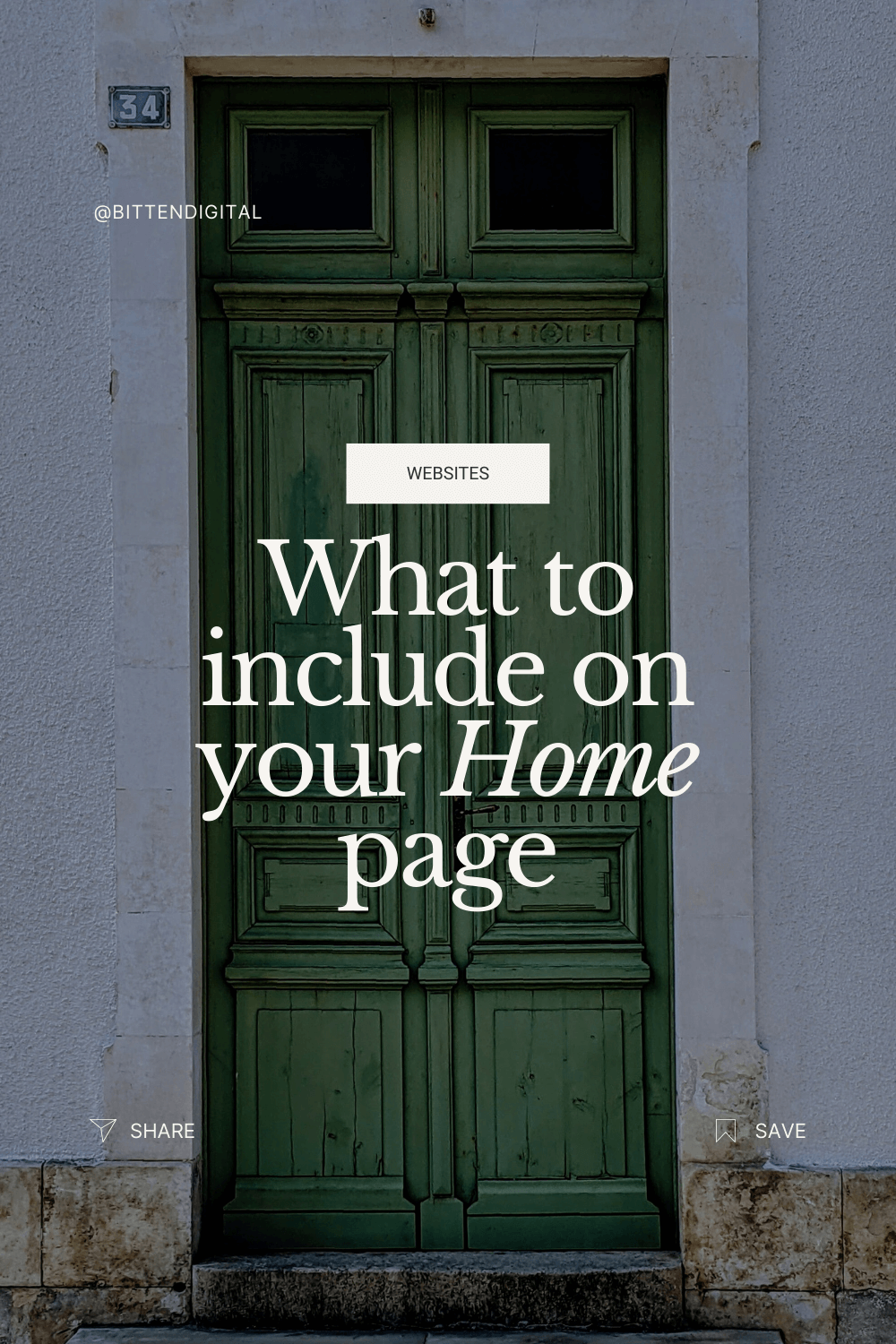What to Include on Your Website Home Page
Designing a website for your business can feel stressful. Your home page is often the first impression potential customers will have of your business, so it's important to get it right. In this blog post, I’ll walk you through key elements to include on your home page to maximise customer engagement, while maintaining a strong brand message.
I would add that, before you begin with your website content, you’ve already taken time to establish:
Who your ideal customer is - as you want your website to speak to them, not just about you.
Your branding, brand tone, and brand values - important to weave into your website to make it unique and tailored to your business.
Your goals for the website - this could be direct sales, booking, or downloads, for example. Knowing this helps to align your site with your business goals.
Where should you start with your home page? We all need a hero…
Let’s start at the beginning, with what is often referred to as ‘above the fold’, or the ‘hero section’. See what I did there?! 😉 The hero section is what the viewer sees before they scroll, at the top section of your page. Not to be confused with the header, which typically contains your logo and website navigation - we’ll cover that another time.
First impressions count, and I like to deploy a 5-second test here. Within the first 5 seconds of landing on your home page, can you answer the following questions: What do you do? And who do you do it for?
If you can answer these questions clearly, you help your visitor know if they’re in the right place. This is why the imagery and text placed at the top of your home page - the hero section - are important, and typically feature:
Banner image
Heading
Subheader/tagline
Call to action button (i.e. shop now, book a table, schedule a call)
Make sure it's clear, concise, and prominently displayed. Avoid jargon and keep it simple, keeping in mind what your ideal customer wants and needs. For example, if you run a bakery, a value proposition might be: "Delicious, Freshly Baked Goods Delivered to Your Doorstep."
Key Services or Products
The second thing I like to include on a home page is a summary of key products and/or services. This further clarifies that the user is in the right place. Notice I said summary, because you need to think of your homepage as a shop window - it should cover key services at a glance, then take people to individual product or service pages for full details.
Your key products/services section should be succinct and solution-based, to encourage the reader to explore one or more of them further.
You also don’t have to include all of your services; we don’t need a full menu here, so think of sharing just the key services for now, or consider the use of categories. Use high-quality images and brief descriptions to highlight what you offer. This not only informs visitors about your offerings but also entices them to explore further. Each of these key services then leads off to a full page on that offering - great for user experience but also for search engines like Google.
Social Proof
Firstly, what is social proof? It just means positive words from your previous customers, rather than just you saying you’re great at what you do. Social proof is a powerful tool for building credibility and trust. Including testimonials from happy customers, reviews, or any awards and recognitions your business has received adds a lot of weight. Real quotes and photos of satisfied clients can make a significant impact. If possible, link these testimonials to case studies or detailed reviews for added authenticity.
An About Me Section
People like to know the humans they're doing business with, especially in the digital age we’re in. Include a brief About Me or About Us section on your home page that gives a personal touch, sharing a bit about your story, mission, and values. This can help build trust and connection with your audience. Link this section to a more detailed About page where visitors can learn more. Please do not be afraid to include photos of yourself here; people buy from people, and it’s much easier to connect with a person than a faceless brand.
Newsletter Signup or Lead Magnet
Your home page is the perfect place to encourage users to sign up to your mailing list, either by offering them a freebie or discount, or by telling them the benefits they will gain from subscribing. There are great reasons to launch a newsletter; even if you don’t want to use it for sales, it’s a space you can connect with your customers and followers. Consider your subscribers your VIP followers - they are the only ones specifically asking you to tell them your news, directly to their inbox. My newsletter, for example, includes social media platform updates, key marketing dates, a weekly quick fix for marketing and some easy content ideas (you can subscribe here 💌😉).
Latest News or Blog Posts
If you have a blog, feature your latest posts on the home page. This not only keeps your content fresh but also showcases your expertise and keeps visitors coming back for more. Regularly updated content is also beneficial for SEO, helping your website rank higher in search engine results. It’s also a great way to show credibility within your industry or specialism.
A Feature Section
A feature section is perfect for sharing the latest news, new services, updated product ranges and anything you are promoting at the time. It could even be used as a ‘save the date’ or ‘coming soon’ feature. Keep it contrasting in style so it really stands out on the page.
One Prominent Call to Action (CTA)
While the different sections of your home page should lead to different pages, you should have one prominent button that stands out. Your CTA is critical for guiding visitors towards the next step you want them to take, whether that's making a purchase, signing up for a newsletter, or contacting you for more information. Place your primary CTA in the hero section, and make it stand out with a contrasting colour and compelling text. For instance, "Shop Now," "Get a Quote," or "Sign Up Today."
Visual Appeal
Your home page should be visually appealing and reflect your brand's identity. Use a cohesive colour scheme, professional images, and readable fonts. Ensure your website is mobile-friendly, since many users will access your site from their smartphones. A clean, uncluttered design helps visitors focus on your content and CTAs.
Other Elements You Might Like to Include
An image gallery or portfolio - if you’re a photographer, a web designer like me, or in another visual field, adding an image gallery to show off your style of work can be a great addition. Just include your best shots, then lead off to a full portfolio or gallery page.
Video content - if you‘re a coach, speaker, or videographer, for example, you might benefit from including a video on your home page in a prominent place.
‘As featured in’ logos - if you’ve been featured in publications, include logos as further social proof
A search function - great for directory and blogging websites, where you might have a lot of browsable content.
Your location - if you serve a particular area, and especially if you are hoping for good local SEO, including the name of your location on the home page is incredibly useful. You can even list out the areas you cover, or include them in an FAQ section (where do we cover? How far to we deliver?).
Gift card link - if you’re a bricks and mortar or ecommerce business, including a Gift Card link on the home page is a great way to boost sales, especially popular around occasions like Christmas, Mother’s Day and Father’s Day.
Wait, what about the Header and Footer?
While your header and footer are super important, I’ll cover those another day, as they deserve their own blog posts. However, I will say that your aim should be to keep your header navigation simple and succinct - think of it as a way to guide your visitors around your site, and not just list out all of your web pages
Conclusion - what to include on your home page
A well-designed home page is crucial for making a strong first impression and guiding visitors towards becoming customers. By including these key elements, you can create a home page that not only looks great but also drives business growth. If you need help updating your website, I’m always happy to help, we offer design days for updating and making over existing websites. Or, if you want to start something new, you can explore our website design options.
For more tips on website design and digital marketing, follow along for more. I’ll be sharing regular updates and inspiration to help you succeed in your business journey.

